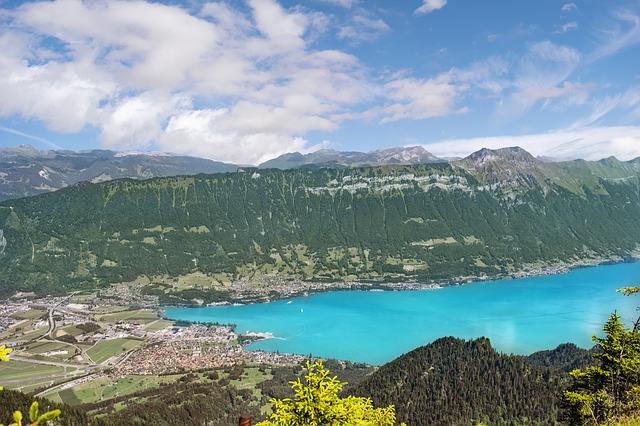Posted on 18 November 2022
When looking at beautiful global regions, the Swiss alps shine brightly. Sharing the southern alpine range with other countries like Liechtenstein, Italy, Austria and France, the northern Bernese and Appenzell Alp ranges sit entirely in Switzerland. As well as those rolling green Swiss plateaus that turn into blankets of snow during winter, the Swiss alps boast majestic mountain tops like Dufourspitze, Dom, Liskamm, Weiss horn, and Matterhorn ranging in altitude from 4478 to 4634 metres.
Of this 60%, 3% of landscapes are dramatic glaciers that make the Swiss alps popular places for hiking. Tourism first started in 1811, with hikers setting up camps. Then, in the mid-nineteen century, hotels were built. Since then, the Swiss alps have become Switzerland‘s prettiest place to visit all year round to enjoy outdoor activities at high altitudes. Making up 60% of Switzerland, the Swiss alps are as important as the cultural heritage of delicious chocolate, branded watches, and cheese. So, let’s look at what to know about the weather, climbing, life, nearby Swiss cities, wildlife, shores and destinations of this part of Switzerland.
Guide to the Swiss Alps

Getting Around
Getting to the Swiss alps is easy by flying into Geneva or Zurich airport. Don’t think of alpine villages in the Swiss alps as hard to get around, though, because Switzerland connects all through public transport, including the Golden Pass line, Post Bus, Rhaetian Railway, Matterhorn Gotthard Bahn and Swiss Federal Railways. If heading to mountain villages from other places in Switzerland, relax and enjoy the journey because most are within a three-hour drive.
Are the Bernese Alps the Same as the Swiss Alps?
Also known as the Bernese highlands or the Bernese Oberland, the Bernese alps is part of the larger Swiss Alps region. Prominent places include Interlaken, the Jungfrau massif, and Gimmel wad. Most tourists head to the Jungfrau section of the Bernese alps since this offers various tourist attractions and things to do.
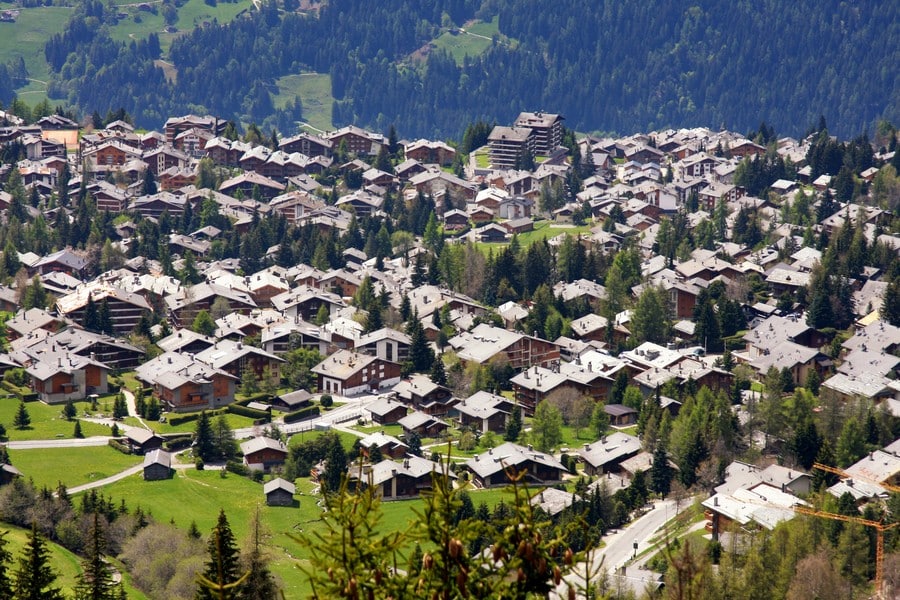
What are the Swiss Alps Known For?
Swiss National Park: First opening in 1914, Switzerland’s only park protects flora and fauna. Sitting in the Western Rhaetian Alps of eastern Switzerland, visitors enjoy various trekking, wildlife, Mother Nature’s beauty and hiking trails.
Lake Walen and Seerenbach Waterfalls: Lake Walen belongs to Heidi land in eastern Switzerland. Surrounded by mountains, plateaus, and small, traditional Swiss towns like Quinten, also visit nearby 600-metre Seerenbach waterfalls in spring, when melting snow kicks them into action. Another famous Swiss Alp town is Amden, or winter sports enthusiasts should head to Flumserberg.
Furka Drive: For the best Swiss Alp trip, head through Furka Pass, one of Switzerland’s unique experiences behind the steering wheel. Running from Gletsch to Realp, the James Bond film Goldfinger featured the pass. If you don’t want to drive and admire stunning Swiss scenery instead, catch the steam train from the centre of Gletsch.
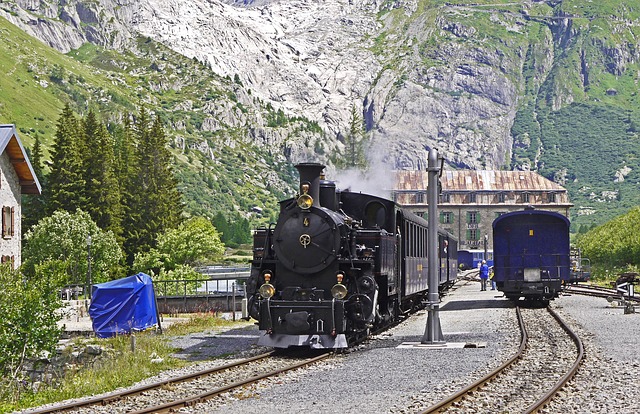
Aare Gorge: Created 10,000 years ago, 165 feet cliffs surround the mile-long limestone Aare gorge of the Alps, and this Swiss walk is pleasant yet exciting. Enter from either side, but the west entrance is more scenic. Since 1889, this Swiss tourist attraction has been one of the Alps’ best things to do.
Grimsel Pass Trip: In bygone eras, travelling traders used this pass to sell their goods, but these days there are three ways to enjoy this popular Alps attraction. First, walk the two-hour trail from Goms to Hasli valley or ride the cable car from Handeck to Gerstenegg. Alternatively, the funicular runs from Handeck to Gilmer lake.
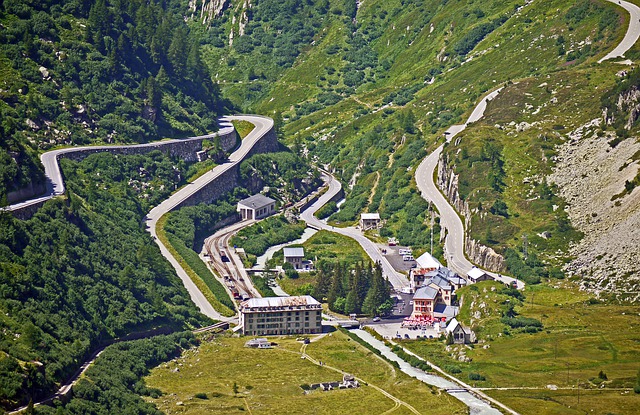
Murren to Schilthorn Trip: First, catch the Alps cable car to Gimmelwald, then onto Murren train station, a delightful car-free Swiss village. From that station, jump onboard the other cable car to Schilithorn peak, standing at 2970 metres. Here, Piz Gloria restaurant, often called Europe’s highest and featured in the James Bond film, On Her Majesty’s Secret Service, reminds us of the Alps power of Mother Nature with snowy peaks and dramatic views. Other famous Alpine landscapes include Davos Klosters, Saint Moritz, Arosa, Grindlewald, Wengen, Verbier, Crans Montana and Laax.
An Alpine Landscape for Skiing
Head to Swiss Alps destinations in the Graubünden, Bernese Oberland and Valais Valley regions. Here, traditional alpine villages with traffic-free streets like Bettmeralp and Rieder alp highlight winter at its best. Switzerland’s ski valleys open from December to April, although Swiss resorts like Saas fee and Zermatt boast summer ski seasons. Alongside time-honoured traditions, visitors also indulge in snowboarding, sledge-biking, and snowmobiles. Three popular Swiss skiing resorts include
Stylish Verbier: Sitting on a south-facing plateau overlooking Combins and Mont-Blanc ranges, Verbier benefits from stunning views and sunshine. The ski resort lies just 0.5 km from the village centre. This part of Switzerland, which is French-speaking, is southwest and close to France and Italy’s borders.
Flims Waldhaus: Charming Flims Waldhaus, Laax and Falera resorts make up one of Switzerland’s largest winter sports areas. This well-connected Swiss region offers an impressive 220 kilometres of pistes over 100 square km; hence skiers enjoy snow-covered slopes.
Crans Montana: A wonderland of white awaits when visiting Crans Montana in Switzerland during winter. This resort is the heart of the French-speaking Swiss Alps, 1,500 m (4,920 ft) above sea level. Serving up picturesque views of the Valais Alps, expect 1668 hikes and the Weisshorn, which translates means white peak/mountain top.
Train Express Rides
One enjoyable way to explore the Alps is on scenic journeys. For example, Glacier Express passes over valleys, rivers, and gorges and is Switzerland’s most scenic ride from Zermatt to St Moritz. Another option is the 675 miles Bernina Express Pass, sitting at 7000 feet, which runs from Chur to Tirano in Italy and features Swiss Alp Mountain landscapes to take your breath away. Another great choice is the Gornergrat railway through Zermatt, offering marvellous Matterhorn views. Otherwise, head to Jungfraujoch, the highest railway station in the Swiss Alps.
Iconic Matterhorn
The Swiss Alp’s most photographed mountain is Europe’s highest peak stretching for an incredible 4500 meters. Hence, the nickname “mountain of mountains” never fails with dramatic plateau views quite unlike anywhere else in the world. The closest town to Matterhorn is Zermatt.
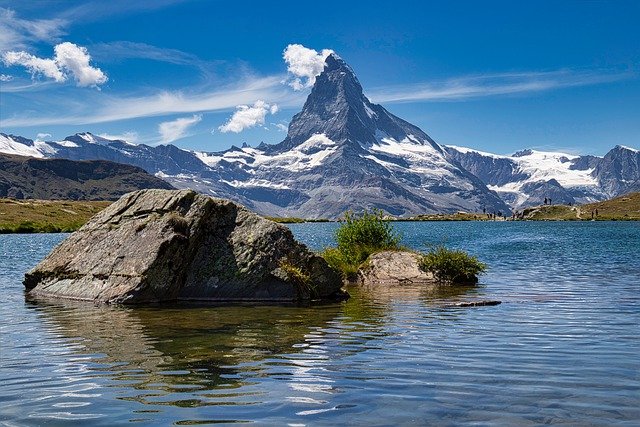
The Great Aletsch Glacier
The great Aletsch Glacier covers 50 square miles and lures daytime visitors with stunning ice landscapes and exciting Swiss hiking trails. Some visitors explore the glacier on foot, while others head straight to the top onboard the cable car. The glacier sits within the UNESCO World Heritage site region of Jungfraujoch, also home to the Swiss Alp Sphinx Observatory. Called the top of Europe, the sight of Bernese Oberland peaks from observation decks are some of Switzerland’s highest. Also, try the nearby First Cliff walks, but only if you like heights. Nearby the Rhone River, visitors step into an ice chamber grotto crafted yearly. Altogether out of 1800 glaciers in the Swiss alps, Aletsch is the most famous.
Lakes in the Swiss Alps
Interlaken in the Swiss Alps: From Interlaken shores, explore surrounding attractions. This includes Harder Kulm, which gives off dramatic views of the Bernet Oberland region and is reached via funicular train. Interlaken’s activity sports include paragliding, rafting, and canyoning in the Alps for something more adventurous. Also famous are Thun and Brienz lakes, two unique delights of Interlaken during spring through to Autumn. Interlaken is considered a must-visit place, where the alps meet the Swiss Prealps.
Lake Geneva: As the largest lake in Central Europe, Lake Geneva is shared by France and Switzerland and overlooked by the Alps. Visitors to the alps should visit Lake Geneva to take ferry trips around the towns. Notable places include Geneva city, Montreux, Chillon, Villeneuve, Vevey and Le Bouveret.
Lake Constance: Germany, Austria and Switzerland border the other famous lake in the Swiss Alps, Lake Constance. Often called the most beautiful lake in Europe, much belongs to Germany, yet still take the detour, if in that area. Places like Swiss Konstanz are known for their impressive historic 11th-century church.
More About the Swiss Alps
Between the French and Swiss Alps: The central Alps stretch across five countries, with hundreds of villages and towns. As home to some of Switzerland’s most famous places when heading for the slopes, home buyers might already have solid ideas about whether to search for property for sale in the French Alps or Switzerland, but what if you are undecided?
7 More Places in Switzerland: Owning property in the Swiss Alps is living amongst world-famous scenery. So potential buyers looking for Alpine property can enjoy spectacular natural beauty anytime they want! Whether you buy in Verbier or Flims, there are some fantastic things to see in Switzerland. Check out our favourite sites in Switzerland, filled with incredible architecture and postcard-pretty destinations.
